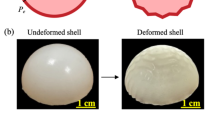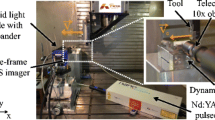Abstract
Polishing abrasives play a crucial role in polishing and significantly influence the polishing rate and quality. Current research on direct observation of abrasives under polishing tools with complicated surface textures is limited. In this work, high speed camera is applied to observe the abrasives under morphable polishing tools with smooth, labyrinth and dimple textures at the tool rotational speed (300, 600 and 900 rpm) and tool offset (0.2, 0.5 and 1 mm). The results shows that the number of abrasives in the contact area is increased with the tool rotational speed and decreased with the tool offset. Among the three tools, dimple tools retain more abrasives than labyrinth and smooth tools. Abrasive trajectories are nearly horizontal, in accordance with the polishing velocity direction. The velocity magnitude is mainly influenced by the horizontal velocity u, as the vertical velocity v is relatively small. The velocity magnitude increases with the tool rotational speed and the tool offset. Among the three tools, the velocity is higher under labyrinth and dimple tools than under smooth tools. The pressure and abrasive velocity were increased by ~ 25% and 70%, while the resultant removal volume was increased by 54.2% with a dimple tool than a labyrinth tool.

















Similar content being viewed by others
References
Nagalingam, A. P., Toh, B. L., & Yeo, S. H. (2023). Surface polishing of laser powder bed fused inconel 625 surfaces using multi-jet hydrodynamic cavitation abrasive finishing: an emerging class of cleaner surface enhancement process. International Journal of Precision Engineering and Manufacturing-Green Technology. https://doi.org/10.1007/s40684-022-00471-7
Zhu, Y. S., Wu, J., Lu, W. Z., Zuo, D. W., Xiao, H. P., Cao, D. W., & Ko, T. J. (2022). Surface formation mechanics and its microstructural characteristics of AAJP of aluminum alloy by using amino thermosetting plastic abrasive. International Journal of Precision Engineering and Manufacturing-Green Technology. https://doi.org/10.1007/s40684-020-00284-6
Fang, F. Z., et al. (2013). Manufacturing and measurement of freeform optics. CIRP Annals, 62(2), 823–846.
Martin, H., et al. (2010). Fabrication and testing of the first 8.4-m off-axis segment for the Giant Magellan Telescope. In Modern Technologies in Space-and Ground-based Telescopes and Instrumentation. SPIE
Axinte, D. A., et al. (2005). Investigations on belt polishing of heat-resistant titanium alloys. Journal of Materials Processing Technology, 166(3), 398–404.
Zhang, S. J., et al. (2015). A review of surface roughness generation in ultra-precision machining. International Journal of Machine Tools and Manufacture, 91, 76–95.
Kadirgama, K., et al. (2009). Surface roughness prediction model of 6061–T6 aluminium alloy machining using statistical method. European Journal of Scientific Research, 25(2), 250–256.
Marinescu, I. D., Uhlmann, E., & Doid, T. (2006). Handbook of lapping and polishing. CRC Press.
Deaconescu, T., & Deaconescu, A. (2020). Developing an analytical model and computing tool for optimizing lapping operations of flat objects made of alloyed steels. Materials, 13(6), 1343.
Cho, S.-S., Ryu, Y.-K., & Lee, S.-Y. (2002). Curved surface finishing with flexible abrasive tool. International Journal of Machine Tools and Manufacture, 42(2), 229–236.
Momber, A. (2007). Blast cleaning technology. Springer Science & Business Media.
Humphrey, J. (1990). Fundamentals of fluid motion in erosion by solid particle impact. International Journal of Heat and Fluid Flow, 11(3), 170–195.
Karpuschewski, B., Hoogstrate, A., & Achtsnick, M. (2004). Simulation and improvement of the micro abrasive blasting process. CIRP Annals, 53(1), 251–254.
Turenne, S., & Fiset, M. (1993). Modeling of abrasive particle trajectories during erosion by a slurry jet. Wear, 162, 679–687.
Zhu, W.-L., et al. (2019). Theoretical and experimental investigation of material removal mechanism in compliant shape adaptive grinding process. International Journal of Machine Tools and Manufacture, 142, 76–97.
Li, J., et al. (2019). Formation mechanism and quality control technology for abrasive flow precision polishing vortex: large eddy simulation. The International Journal of Advanced Manufacturing Technology, 105(5), 2135–2150.
Lee, H., Kim, H., & Jeong, H. (2022). Approaches to sustainability in chemical mechanical polishing (CMP): a review. International Journal of Precision Engineering and Manufacturing-Green Technology, 9, 349–367.
Stevenson, A., & Hutchings, I. (1995). Scaling laws for particle velocity in the gas-blast erosion test. Wear, 181, 56–62.
Li, H., Wang, J., & Fan, J. (2009). Analysis and modelling of particle velocities in micro-abrasive air jet. International Journal of Machine Tools and Manufacture, 49(11), 850–858.
Ihara, M., Matsubara, A., & Beaucamp, A. (2020). Study on removal mechanism at the tool rotational center in bonnet polishing of glass. Wear, 454, 203321.
Cheng, Z., et al. (2020). Investigation of the trajectory uniformity in water dissolution ultraprecision continuous polishing of large-sized KDP crystal. International Journal of Extreme Manufacturing, 2(4), 045101.
Qi, Z., Lu, W., & Lee, W. (2014). A hydrodynamic and kinematic analysis of chemical–mechanical planarization mechanism in double sided polisher. International Journal of Machine Tools and Manufacture, 82, 59–67.
Yin, S., & Shinmura, T. (2004). A comparative study: Polishing characteristics and its mechanisms of three vibration modes in vibration-assisted magnetic abrasive polishing. International Journal of Machine Tools and Manufacture, 44(4), 383–390.
Zhao, J., et al. (2000). An oblique ultrasonic polishing method by robot for free-form surfaces. International Journal of Machine Tools and Manufacture, 40(6), 795–808.
Zhao, Q., Sun, Z., & Guo, B. (2016). Material removal mechanism in ultrasonic vibration assisted polishing of micro cylindrical surface on SiC. International Journal of Machine Tools and Manufacture, 103, 28–39.
Zhang, Z., et al. (2023). Modelling of surface morphology and roughness in fluid jet polishing. International Journal of Mechanical Sciences, 242, 107976.
Wang, Z., et al. (2019). Analytical model of dynamic and overlapped footprints in abrasive air jet polishing of optical glass. International Journal of Machine Tools and Manufacture, 141, 59–77.
Sooraj, V., & Radhakrishnan, V. (2014). Fine finishing of internal surfaces using elastic abrasives. International Journal of machine tools and manufacture, 78, 30–40.
Wang, C., et al. (2020). Design and application of an algorithm for measuring particle velocity based on multiple characteristics of a particle. Fuel, 271, 117605.
El-Adawy, M., et al. (2021). Stereoscopic particle image velocimetry for engine flow measurements: Principles and applications. Alexandria Engineering Journal, 60(3), 3327–3344.
Haidari, A., Heijman, S., & Van der Meer, W. (2018). Effect of spacer configuration on hydraulic conditions using PIV. Separation and purification technology, 199, 9–19.
Thaker, A. H., Karthik, G., & Buwa, V. V. (2019). PIV measurements and CFD simulations of the particle-scale flow distribution in a packed bed. Chemical Engineering Journal, 374, 189–200.
Kang, S., et al. (2020). Characterization of pleated filter media using particle image velocimetry. Separation and Purification Technology, 237, 116333.
Liu, R., et al. (2020). Particle velocity distribution function around a single bubble in gas-solid fluidized beds. Powder Technology, 361, 33–44.
Atxutegi, A., et al. (2019). Implementation of a borescopic technique in a conical spouted bed for tracking spherical and irregular particles. Chemical Engineering Journal, 374, 39–48.
Belloň, T., Slouka, Z. (2022). Overlimiting convection at a heterogeneous cation-exchange membrane studied by particle image velocimetry. Journal of Membrane Science, 643, 120048. https://doi.org/10.1016/j.memsci.2021.120048
Cao, Z.-C., & Cheung, C. F. (2016). Multi-scale modeling and simulation of material removal characteristics in computer-controlled bonnet polishing. International Journal of Mechanical Sciences, 106, 147–156.
Thielicke, W., & Sonntag, R. (2021). Particle Image Velocimetry for MATLAB: Accuracy and enhanced algorithms in PIVlab. Journal of Open Research Software. https://doi.org/10.5334/jors.334
Author information
Authors and Affiliations
Corresponding author
Additional information
Publisher's Note
Springer Nature remains neutral with regard to jurisdictional claims in published maps and institutional affiliations.
Rights and permissions
Springer Nature or its licensor (e.g. a society or other partner) holds exclusive rights to this article under a publishing agreement with the author(s) or other rightsholder(s); author self-archiving of the accepted manuscript version of this article is solely governed by the terms of such publishing agreement and applicable law.
About this article
Cite this article
Nie, Q. Observation of Abrasives Under Morphable Polishing Tools with a High-Speed Camera. Int. J. Precis. Eng. Manuf. (2024). https://doi.org/10.1007/s12541-024-00989-7
Received:
Revised:
Accepted:
Published:
DOI: https://doi.org/10.1007/s12541-024-00989-7




